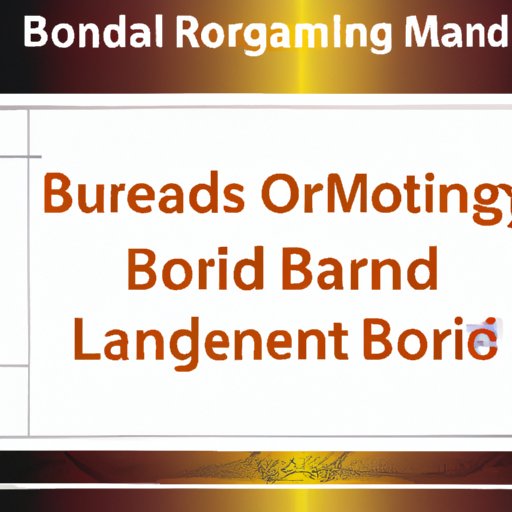Introduction
Bonds are debt instruments issued by governments, corporations, or other entities in order to raise capital. When you purchase a bond, you are essentially lending money to the issuer in exchange for regular interest payments over the life of the bond. Bonds can be an attractive investment option for those looking for steady income and minimal risk, as they tend to offer higher yields than savings accounts and CDs, and are generally less volatile than stocks.
Types of Bonds
When it comes to bonds, there are three main types to consider: government bonds, corporate bonds, and municipal bonds.
Government Bonds
Government bonds are issued by national governments and typically have the lowest level of risk associated with them. Government bonds can be further broken down into treasury bonds, treasury notes, and treasury bills. Treasury bonds are long-term investments that typically have maturities of 10 years or more, while treasury notes have maturities of 2-10 years, and treasury bills have maturities of one year or less.
Corporate Bonds
Corporate bonds are issued by companies in order to raise capital for business operations. The risk associated with corporate bonds is usually higher than government bonds, as there is no guarantee that the company will be able to make its interest payments or repay its debt. However, corporate bonds generally offer higher yields than government bonds.
Municipal Bonds
Municipal bonds are issued by state and local governments in order to finance public projects such as roads, bridges, and schools. These bonds are generally considered to be relatively safe investments, as they are backed by the full faith and credit of the issuing government. They also offer tax advantages in some cases, as the interest income is exempt from federal taxes and may also be exempt from state and local taxes.

Steps for Researching and Selecting the Right Bond
Before buying a bond, it’s important to research the different types and understand which ones best fit your risk tolerance and investment goals. Here are some key factors to consider when selecting a bond:
Understand Your Risk Tolerance and Investment Goals
It’s important to assess your risk tolerance and investment goals before investing in any type of bond. Generally speaking, government bonds are safer investments with lower yields, while corporate and municipal bonds offer higher yields but come with a greater risk of default.
Compare Bond Interest Rates
When comparing different bonds, it’s important to look at the interest rate offered. Generally speaking, the higher the interest rate, the higher the yield. It’s also important to factor in inflation when considering bond interest rates, as the value of the interest payments may be eroded by inflation over time.
Analyze Bond Ratings
It’s also important to look at the ratings assigned to each bond. Bond ratings are assigned by rating agencies and provide an indication of the creditworthiness of the issuer. Generally speaking, the higher the rating, the lower the risk of default.
Consider Other Factors, Such as Maturity Date and Call Provisions
In addition to interest rates and ratings, it’s also important to consider other factors such as the maturity date and call provisions. The maturity date is the date on which the bond will mature and the principal must be repaid. Call provisions allow the issuer to redeem the bond before the maturity date, so it’s important to understand these provisions before investing.
Costs Associated with Buying a Bond
When purchasing a bond, there are several costs to consider. These include brokerage commissions, transaction fees, and bid-ask spreads. Brokerage commissions are charged by the broker for executing the trade, while transaction fees are charged by the exchange or market maker for facilitating the trade. Bid-ask spreads refer to the difference between the price at which a buyer is willing to purchase the bond and the price at which a seller is willing to sell the bond.

Opening a Brokerage Account and Purchasing a Bond
Once you’ve done your research and selected the right bond, the next step is to open a brokerage account and place an order. The first step is to choose a brokerage firm that offers the types of bonds you’re interested in. Once you’ve chosen a firm, you can open an account and fund it with the necessary amount of cash. Finally, you can place an order for the bond you’ve selected.
Diversifying a Bond Portfolio
Once you’ve purchased a bond, it’s important to diversify your portfolio in order to minimize risk and maximize returns. The best way to do this is to invest in different types of bonds, such as government bonds, corporate bonds, and municipal bonds. It’s also important to consider investing in different sectors, such as energy, technology, and healthcare. Finally, it’s important to balance risk and reward when constructing a bond portfolio, as too much exposure to high-risk bonds can lead to significant losses.
Conclusion
Buying a bond can be an attractive investment option for those looking for steady income and minimal risk. It’s important to understand the different types of bonds, their associated costs, and strategies for diversifying a bond portfolio in order to maximize returns. By following these steps, you can be well on your way to building a successful bond portfolio.


